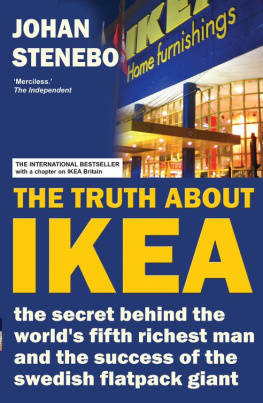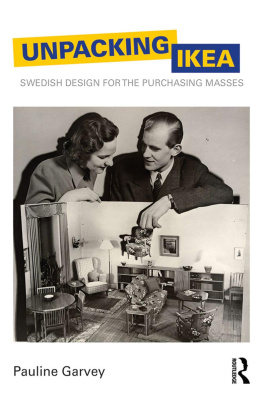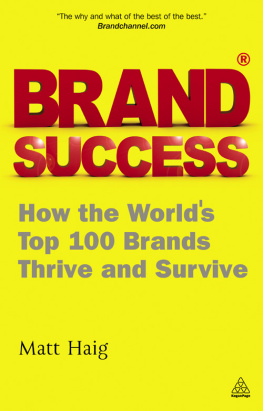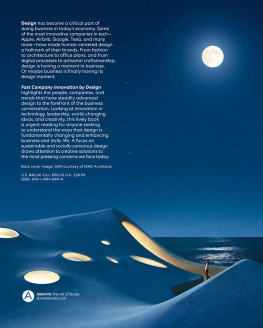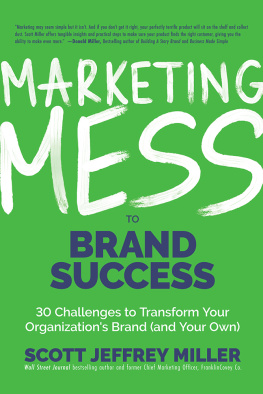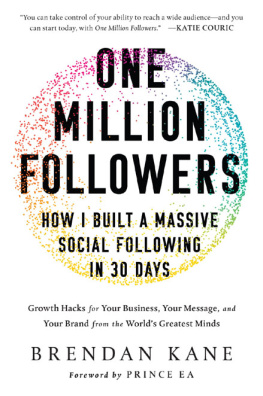After 20 years with the company, I left IKEA around New Year 2009. Nonetheless, a bit unexpectedly my memories of IKEA didnt fade away. Experiences from the past re-appeared, new outlines and conclusions took shape and fundamentally changed my understanding of IKEA. As new questions demanded answers, the IKEA I now viewed from the outside changed completely. A new truth about my ex-employer saw the light of day.
I wish to point out that it is my truth and that it is based entirely on my two decades in the corridors of power at IKEA.
I want to thank Stefan, Maria and Madeleine for all their help with the book. As well as my colleagues Mikael Bragd and Gran Swedrus from Retail Factory AB without whose advice and assistance I would have stood alone. Obviously also my editors Bjrn berg and Susanne af Klercker who have so successfully enhanced my manuscript, solicitor Dan Engstrm for all his advice, Martin Jonsson and Ola Mork from Morkman AB and last but not least the editorial staff at Forma Publishing Group that made this book possible in a relatively short period of time.
Most people know that a visit to an IKEA store can be a truly unpleasant experience. But how disagreeable a Saturday at IKEA can be with sold-out stock, crowds and queues for everything from checkouts to hot dogs is nothing compared to the bizarre exploitation and ill-treatment of customers by the IKEA group with Ingvar Kamprad at the helm from the middle of the nineties and onwards in Great Britain.
It may sound somewhat exaggerated to accuse a company of exploiting its customers. The fact is that this is the most appropriate word I can find for it. Let me start at the beginning in order to describe how Great Britain became the golden goose of IKEA. The company established itself relatively late in the British Isles, in 1987, in comparison to almost all economically important nations in Europe. The first store was in Warrington outside Manchester, after which followed another four stores in the Midlands, Newcastle and London. A substantially larger store was built in the London council of Brent Park, an area known for its social problems and high criminality (the store is nowadays called Wembley on the company homepage). Next to the store, the UK managing director at the time Birger Lund erected an ugly discolored building with far too many floors which was to house the British head office for a number of years. Nine years later, in 1995, IKEA still had five stores in a country which counted well over 50 million inhabitants and was one of the largest economies in the world. In other words, the company and its brand led a dormant existence there.
But the Swedish home furnishing company eventually grew in importance with the British public. In the companys particular niche of Scandinavian-designed furniture at low prices, competition was, compared to many other IKEA-markets, largely nonexistent. At the beginning of the nineties the IKEA brand reached a critical mass as far as the degree of recognition was concerned and turnover took off at the five stores. Also internally within IKEA, not least with its owner Ingvar Kamprad, the enormous potential of the UK market became obvious. IKEA had become the in-thing in Britain and IKEA UK an established part of the group.
Under the leadership of Birger Lund, IKEA UK was not a very impressive selling machine. Birger was an able financial controller, and later became manager for the Kamprad brothers own multimillion group IKANO with banking as an important activity. However not only did he, as a manager, lack the deep commercial knowledge that IKEA needed in Britain, at the time the entire group lacked a coherent commercial concept. Most things did therefore not work out well in IKEA stores. In the British stores things were even worse. The room interiors faced the wrong way against the customer flow, price labels were in the wrong place, if items had a price label at all, best-sellers were displayed to their disadvantage and important products were constantly running out. These were blunders that within IKEA Germany, the shining star within the group at the time, were considered as breach of duty with a subsequent written warning or even dismissal, but they seemed not to stand in the way of promotion on the other side of the English channel.
It was hardly surprising when Birger Lund was promoted sideways and upwards to manager of IKEA Sweden by IKEAs pompous Northern Europe manager Bengt Larsson. Bengts previous financial controller, Ingvars former assistant and the future Chief Executive Anders Dahlvig became UK manager.
During the years with Dahlvig at the helm, IKEA UK Ltd went from a backward position both, financially as well as commercially, to the top of the IKEA group. Dahlvig had rare qualities of leadership and breadth of knowledge. He instilled confidence in his British co-workers who during the previous years had been deprived of their self-esteem by conceited Swedish managers speaking English much like the Swedish chef in the Muppet show. Dahlvig took advantage of the IKEA-fever that at the time was spreading across England, by making the most of the marketing so that the stores were filled with customers, and by drastically elevating the commercial standards to make as much money from them as possible.
New stores were built in Leeds (mentioned later in the book), Thurrock and Nottingham whilst the old ones, by now rather run down metal boxes, were rebuilt and refurbished. However, during the same period of this wave of success at IKEA UK, the first British law on retail outlets saw the light of day. The main purpose of this legislation was to protect shops in the inner cities against competition from the enormous shopping precincts which were mushrooming outside the town centres. The result was that IKEA, being a large foreign company with enormous stores outside the town centres as part of its strategy, would rarely be granted permission to construct new centres.
IKEA UK rapidly shot up in the sales statistics and suddenly the UK divsion had the biggest growth rate within the group. It was an outstanding success. The crowds of visitors grew dramatically year on year in a way that the group had never experienced anywhere else in the world. But it was millions of new and old IKEA-enthusiasts who were forced to share with each other the same miserable experience as before, in the same handful of stores. Each year the pressure on the stores, on the co-workers and the logistical resources increased to cater for a flow of customers that never ran dry.
Naturally there were plenty of advantages with the enormous growth of IKEA in Great Britain. First and foremost the turnover increased. Within a few years the market went from being one of the IKEA-worlds more mediocre selling machines to a position amongst the third or fourth most successful, on a par with Germany and North America, in monetary terms. Obviously it is not enough to just have enormous crowds of customers in order to increase sales. Equally important is to put up the prices as much as the wallets of the customers allow. But that is not one of IKEAs core strategies. It was Dahlvig who introduced this unusual pricing strategy in the UK, nonetheless. After all IKEA had always stood by the motto beautiful furniture at affordable prices. Having had previous experience as a successful controller he decided that since there was no competition at all IKEA could demand any price they wanted in the British market. This was his interpretation of the comprehensive pricing strategy of the group: IKEA prices should always be ten per cent lower than comparable products by competitors. All of a sudden IKEA found itself in a market without competition on comparable products and it quickly lost all self-control. Soon enough IKEA UK had the highest sales price of the entire worlds subsidiaries apart from IKEA USA (whose high price are pushed up by exceptionally high marketing costs rather than policy), an embarrassing pricing strategy the company has maintained to this day as far as I can judge from prices in Europe.

